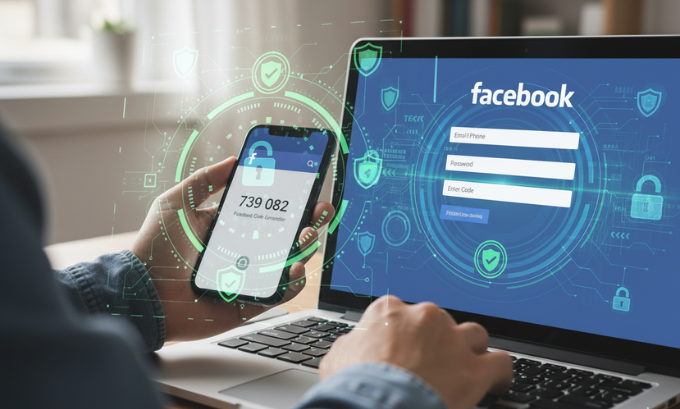Facebook remains one of the world’s most targeted platforms for cybercriminals. With over 3 billion active users sharing personal information, photos, and business data, your Facebook account represents a goldmine for hackers. The question isn’t whether you’ll be targeted—it’s whether you’ll be prepared when it happens.
Securing your Facebook account requires more than just a strong password. Modern hackers use sophisticated techniques like AI-powered phishing, deepfakes, and social engineering to bypass traditional security measures. This comprehensive guide provides 22 actionable strategies to protect your Facebook account from unauthorized access, data theft, and malicious attacks.
Table of Contents
Understanding the Modern Threat Landscape
Before diving into protective measures, it’s crucial to understand what you’re defending against. Today’s cybercriminals employ advanced tactics that go far beyond simple password guessing.

The Rise of AI-Powered Attacks
Generative AI has revolutionized how attackers approach Facebook security. Criminals now use tools like ChatGPT to craft personalized phishing messages that perfectly mimic your friends’ writing styles. These AI-generated attacks can analyze your public posts, create convincing fake messages, and even generate realistic profile pictures for imposter accounts.
Deepfakes: The New Frontier of Deception
Deepfake technology allows attackers to create convincing video or audio content featuring you or people you trust. Imagine receiving a video message from a “friend” asking you to click a malicious link—except that friend never actually sent it. These sophisticated deepfake attacks are becoming increasingly common on social media platforms.

Business Manager Vulnerabilities
If you manage Facebook Pages or run Meta Ads, your account becomes an even more attractive target. Hackers can gain access to your Business Manager, steal ad budgets, or use your business accounts to launch attacks against your customers and partners.
Essential Facebook Security Features You Must Enable
Facebook provides robust security tools, but many users never activate them. Here’s how to transform your account into a digital fortress.

Two-Factor Authentication: Your First Line of Defense
Two-Factor Authentication (2FA) is the single most effective security measure you can implement. When enabled, Facebook requires both your password and a secondary verification method to access your account.
How to Enable 2FA:
- Navigate to Settings & Privacy > Settings > Security and Login
- Click “Use two-factor authentication”
- Choose your preferred method: authentication app, text message, or security key
For maximum security, avoid SMS-based 2FA. Instead, use authentication apps like Google Authenticator, which generate time-based codes that can’t be intercepted through SIM swapping attacks.
Login Alerts: Your Digital Security System
Facebook Login Alerts notify you whenever someone accesses your account from an unrecognized device or location. This early warning system can help you detect unauthorized access before significant damage occurs.
Setting Up Login Alerts:
- Go to Settings & Privacy > Settings > Security and Login
- Click “Get alerts about unrecognized logins”
- Choose your notification preferences (email, text, or both)
Encrypted Email Notifications
Facebook offers the option to encrypt email notifications using PGP (Pretty Good Privacy) encryption. This prevents cybercriminals from intercepting your security alerts and using them to plan attacks.
For more insights on cybersecurity trends, it’s essential to stay updated on the latest protective measures and emerging threats that could affect your social media security.
22 Essential Strategies to Secure Your Facebook Account
Password Security and Account Management
1. Create an Unbreakable Password
Your Facebook password should be at least 12 characters long and include uppercase letters, lowercase letters, numbers, and special characters. Avoid using personal information like birthdates, names, or common phrases.
2. Use a Password Manager
Tools like LastPass, Dashlane, and 1Password generate and store complex passwords for all your accounts. This eliminates the temptation to reuse passwords across multiple platforms—a critical security vulnerability.
3. Enable Two-Factor Authentication
As discussed earlier, 2FA adds an essential layer of security. Use an authenticator app rather than SMS for better protection against SIM swapping attacks.
4. Regularly Update Your Password
Change your Facebook password every 90 days, or immediately if you suspect your account has been compromised. Never reuse old passwords.
5. Log Out of Unused Sessions
Regularly review your active Facebook sessions in Settings > Security and Login > Where You’re Logged In. Remove any sessions from devices or locations you don’t recognize.
Privacy and Visibility Controls
6. Lock Down Your Privacy Settings
Review and adjust your privacy settings to limit who can see your posts, friend list, and personal information. Navigate to Settings & Privacy > Privacy to customize these controls.
7. Control Who Can Find You
Limit how others can find and contact you by adjusting your discoverability settings. Consider making your email address and phone number unsearchable to reduce targeted attacks.
8. Secure Your Friend List
Make your friend list private to prevent attackers from identifying potential targets for social engineering attacks. A public friend list gives criminals a roadmap to your social connections.
9. Limit App Permissions
Regularly audit third-party applications connected to your Facebook account. Remove any apps you no longer use and carefully review the permissions granted to remaining applications.
Advanced Security Measures
10. Use Facebook’s Security Checkup
Facebook’s Security Checkup tool automatically reviews your security settings and recommends improvements. Access this feature through Settings & Privacy > Privacy Checkup.
11. Enable Login Approval
Login approval requires you to confirm new device logins through a trusted device. This prevents unauthorized access even if someone obtains your password.
12. Set Up Trusted Contacts
Trusted Contacts allows you to designate friends who can help you regain account access if you’re locked out. Choose contacts carefully—they’ll have the power to help reset your account.
13. Monitor Your Account Activity
Regularly check your Recent Activity log for suspicious actions like posts you didn’t create, friend requests you didn’t send, or messages you didn’t write.
Protecting Against Social Engineering
14. Verify Friend Requests Carefully
Cybercriminals often create fake profiles using stolen photos and information. Before accepting friend requests, verify the person’s identity through multiple channels.
15. Be Skeptical of Urgent Messages
Phishing attacks often create artificial urgency. If a friend sends an unusual message asking for money, personal information, or asking you to click a link, verify their identity through a phone call or in-person conversation.
16. Recognize AI-Generated Content
With the rise of AI-powered attacks, be suspicious of messages that seem slightly “off” in tone or content. When in doubt, verify through an alternative communication method.
17. Avoid Clicking Suspicious Links
Hover over links before clicking to preview their destination. Be particularly wary of shortened URLs or links that redirect to unfamiliar websites.
Device and Network Security
18. Keep Your Devices Updated
Ensure your smartphones, tablets, and computers have the latest security patches installed. Outdated devices are vulnerable to malware that could compromise your Facebook account.
19. Use Secure Networks
Avoid accessing Facebook on public Wi-Fi networks. If you must use public Wi-Fi, connect through a VPN to encrypt your data transmission.
20. Install Reliable Antivirus Software
Quality antivirus software can detect and prevent malware that might steal your Facebook credentials. Keep your antivirus definitions updated and run regular scans.
21. Log Out on Shared Devices
Always log out of Facebook when using shared or public computers. Never save your login credentials on devices you don’t personally own and control.
Incident Response and Recovery
22. Know How to Report and Recover
If your account is compromised, immediately report it to Facebook through their Help Center. Change your password from a secure device and review all account activity for unauthorized changes.
Expert Insights from Cybersecurity Professionals
Social media security expert Naveh Ben Dror emphasizes the importance of treating Facebook accounts like valuable assets. “Your Facebook account contains years of personal data, connections, and potentially business information. Protecting it should be a priority, not an afterthought.”
Darlene Antonelli, MA, co-author of numerous cybersecurity guides, recommends a layered security approach: “No single security measure is foolproof. The combination of strong passwords, two-factor authentication, privacy controls, and user awareness creates a comprehensive defense system.”
For more comprehensive information on Facebook security, understanding the latest platform features and security updates is crucial for maintaining account protection.

Understanding Facebook’s Business Security Implications
If you use Facebook for business purposes, securing your account becomes even more critical. Business Manager accounts control valuable assets including:
- Ad accounts with spending authority
- Facebook Pages with thousands of followers
- Customer data and insights
- Brand reputation and messaging
A compromised business account can result in financial losses, damaged customer relationships, and regulatory compliance issues. Consider implementing additional security measures such as role-based access controls and regular security audits.
Meta Ads accounts are particularly attractive to cybercriminals because they provide direct access to advertising budgets. Implement strict financial controls and monitor ad spending for unusual activity.
The Psychology of Social Engineering Attacks
Understanding how attackers manipulate human psychology can help you recognize and resist their tactics. Common psychological triggers include:
- Authority: Messages appearing to come from Facebook or trusted institutions
- Urgency: Claims that immediate action is required to prevent account closure
- Fear: Threats about compromised security or leaked personal information
- Curiosity: Intriguing content designed to encourage clicking suspicious links
Phishing scams often exploit these psychological vulnerabilities. By recognizing these patterns, you can maintain a healthy skepticism when evaluating suspicious communications.
Staying Updated on Emerging Threats
The cybersecurity landscape evolves constantly. Stay informed about new threats by:
- Following reputable cybersecurity news sources
- Attending webinars on social media security
- Participating in security awareness training programs
- Connecting with cybersecurity professionals on platforms like LinkedIn
For the latest updates on cybersecurity trends for 2025, it’s important to stay ahead of emerging threats and adapt your security practices accordingly.
Password Manager Comparison for Facebook Security
| Password Manager | Key Features | Facebook Integration | Pricing |
|---|---|---|---|
| LastPass | Cross-platform sync, password sharing | Browser autofill, mobile app integration | Free tier available |
| Dashlane | Dark web monitoring, VPN included | Seamless Facebook login | Premium plans only |
| 1Password | Family sharing, secure document storage | Advanced security features | Subscription-based |
| Bitwarden | Open-source, business plans available | Full Facebook compatibility | Generous free tier |
Frequently Asked Questions
How often should I change my Facebook password?
Change your password every 90 days or immediately if you suspect compromise. More frequent changes may actually decrease security by encouraging simpler passwords.
Is SMS-based two-factor authentication secure enough?
While better than no 2FA, SMS-based authentication is vulnerable to SIM swapping attacks. Use authenticator apps like Google Authenticator for better security.
What should I do if I receive a suspicious message from a Facebook friend?
Don’t click any links or provide personal information. Contact your friend through an alternative method (phone call, text message) to verify they actually sent the message.
How can I tell if my Facebook account has been hacked?
Warning signs include unfamiliar posts on your timeline, messages you didn’t send, unknown friend requests sent from your account, or login alerts from unrecognized locations.
Should I use Facebook’s “Save Login Info” feature?
Only on personal devices you control completely. Never save login information on shared, public, or work computers.
What’s the difference between Facebook Login Alerts and Login Approval?
Login Alerts notify you of new logins, while Login Approval requires you to approve new device logins through a trusted device.
How do I secure my Facebook Business Manager account?
Implement role-based access controls, require 2FA for all team members, regularly audit user permissions, and monitor ad spending for unusual activity.
Taking Action: Your Facebook Security Checklist
Securing your Facebook account is an ongoing process, not a one-time task. Use this checklist to ensure comprehensive protection:
- Enable two-factor authentication with an authenticator app
- Create a strong, unique password using a password manager
- Configure login alerts for unrecognized devices
- Review and tighten privacy settings
- Audit connected third-party applications
- Set up trusted contacts for account recovery
- Regularly monitor account activity logs
- Keep all devices updated with latest security patches
- Use secure networks for Facebook access
- Stay informed about emerging cybersecurity threats
The digital landscape continues to evolve, and so do the threats targeting your Facebook account. By implementing these 22 security strategies and maintaining vigilant security practices, you can significantly reduce your risk of becoming a cybercrime victim.
Remember that cybersecurity is a shared responsibility. Stay informed, remain skeptical of unusual communications, and don’t hesitate to verify suspicious activity through alternative channels. Your proactive approach to Facebook security protects not only your own data but also helps create a safer online environment for your friends, family, and business connections.
For additional resources on protecting your digital assets, explore comprehensive security guides that cover emerging threats and protection strategies across multiple platforms.

